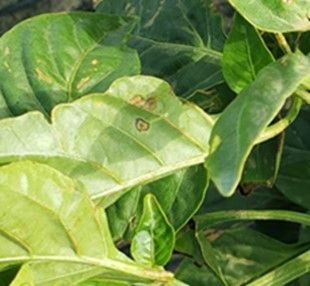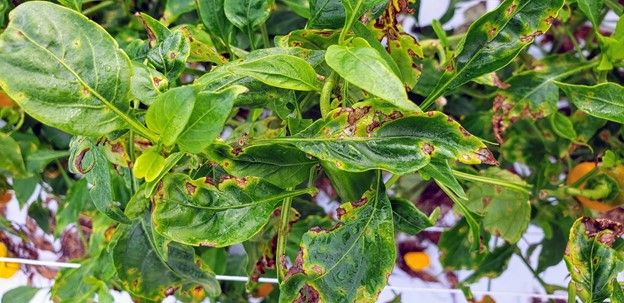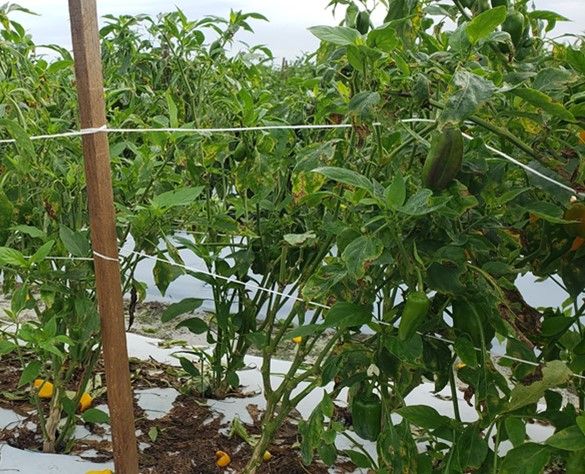Introduction
Pepper fruits in the genus Capsicum are produced worldwide as a fresh vegetable, dried for spices, or used in commercial products such as dietary supplements or natural coloring in cosmetic products. Florida is the second largest producer of sweet bell pepper (Capsicum annuum), providing 32% of what is grown in the United States. In 2019, the acreage of bell pepper production in Florida was 12,000 acres and valued at nearly $235 million USD (nass.usda.gov). In addition to sweet bell, a wide variety of specialty pepper types are also produced in Florida: Thai pepper (C. frutescens), habanero and Scotch bonnet (C. chinense), ají or Peruvian hot pepper (C. baccatum), jalapeño, serrano, and cherry (C. annuum). A limiting disease problem on all peppers is bacterial spot caused by three species of Xanthomonas (X. euvesicatoria, X. perforans, and X. gardneri) (Jones et al. 2004). Xanthomonas euvesicatoria is the predominant species occurring on pepper in the United States, while the other two, X. perforans and X. gardneri, are considered to be of minor importance on pepper. Bacterial spot causes severe defoliation, resulting in reduced plant vigor, exposure of fruit to sunburn, and reduced yield. Infected fruit are unmarketable due to lesions on fruit surface. Total yield losses in severely affected crops can occur.
Symptoms
On the plant, all aboveground plant tissue is susceptible to infection by the bacterial pathogen. On leaves, the first symptoms are water-soaked spots visible on the lower leaf surface within 3 to 4 days of infection. Within another 2–3 days, the lesions become tan to brown and appear slightly greasy on the upper leaf surface (Figure 1). Leaf lesions expand and coalesce to form large areas of yellow and brown tissue with a characteristic greasy appearance (Figure 2). Leaf margins may become scorched due to bacterial invasion of hydathodes. Infected leaves often drop prematurely, even when only moderate damage from bacterial spot is incurred (Figure 3). Premature defoliation leading to thinning of the plant canopy increases incidence of sun scald on fruits. Lesions on fruit appear initially as small, raised blemishes that are a slightly lighter green than the normal fruit color. Fruit lesions enlarge, turn brown to black, and appear as raised warts or scabs (Figure 4). Under humid conditions, other microbes, such as those causing bacterial soft rot, may enter the fruit lesions and cause massive fruit decay.

Credit: P. Roberts, UF/IFAS

Credit: P. Roberts, UF/IFAS

Credit: P. Roberts, UF/IFAS

Credit: P. Roberts, UF/IFAS
Causal Organism and Host Resistance
Bacterial spot in pepper in Florida and worldwide is primarily caused by Xanthomonas euvesicatoria. Xanthomonas perforans is most associated with bacterial spot on tomato, but while generally considered nonpathogenic on pepper, X. perforans was found causing disease on pepper in Florida and Alabama (Schwartz et al. 2015; Newberry et al. 2019). The X. euvesicatoria strains affecting pepper can be divided into eleven races (0 through 10) based on the Bs1, Bs2, Bs3, and Bs4c resistance genes in pepper. A summary of the pepper genes can be found in Table 1. There are six dominant resistance genes (Bs1, Bs2, Bs3, Bs4C, Bs7, and BsT) and two recessive resistance genes (bs5 and bs6). Resistance genes in pepper have been incorporated into new cultivars using traditional breeding methods. Currently available commercial bacterial spot–resistant cultivars contain various combinations of these resistance genes. While some bell pepper varieties have resistance to all known races of X. euvesicatoria, others do not. Many of the specialty and chile pepper varieties do not have gene resistance packages. For more information on pepper varieties and resistance for Florida production, please see the EDIS chapter on Pepper Production in the Vegetable Production Handbook of Florida at https://edis.ifas.ufl.edu/cv130.
Dominant and recessive genes introgressed into pepper that confer resistance to one or more races of Xanthomonas euvesicatoria.
Disease Cycle and Epidemiology
The bacteria are seedborne, and outbreaks of the disease can occur within transplant production. When associated with the seed, plant cotyledons may become infected upon contact with seed coat or upon emerging from the soil (Ritchie 2000). Xanthomonas euvesicatoria can survive on volunteer (tomato/pepper) plants in the field as well as in soil when crop residue is present but not yet decomposed (Potnis et al. 2015). The bacteria can also survive epiphytically on nonhost species within the cropping system. X. euvesicatoria can survive on other solanaceous crops, including tomato. In tomato, X. euvesicatoria is just one of four species that cause bacterial spot. More information on bacterial spot of tomato can be found at https://edis.ifas.ufl.edu/pp353. The bacteria are spread from plant to plant by either water droplets, such as from rainfall or heavy dew, or aerosols containing bacteria. Once these droplets or aerosols encounter host tissues, X. euvesicatoria enters through wounds and various natural openings, including stomata and lenticels. It is not uncommon to observe severely diseased varieties next to relatively unaffected plants in the field, even in the absence of resistance genes in both. Outbreaks are possible whenever warm weather occurs with frequent episodes of wind-driven rain as well as night temperatures above 65°F. These environmental conditions favor the likelihood of bacterial spot developing in pepper plantings. In southern Florida, the most severe outbreaks are observed in the months from August through November, coinciding with the rainy season.
Disease Management
Bacterial spot management requires an integrated approach using several tactics including cultural, sanitation, and chemical control measures.
Cultural and Sanitation Practices
Host resistance is a critical component of an integrated pest management (IPM) strategy to control bacterial spot on pepper. If known bacterial spot infections have occurred in the past, start by choosing a variety that contains resistance genes. Some newer varieties offer resistance genes to all known races, while many of the older varieties do not contain all available resistance genes. Careful consideration should be given to the choice of variety. Consult the Vegetable Production Handbook of Florida (https://edis.ifas.ufl.edu/cv130) for an updated list of pepper varieties. Because bacteria transmission is possible in pepper seed, choose certified disease-free seed when possible. Scouting is a critical component of IPM, and plants in fields and transplant houses should be inspected frequently. Inspect all transplants for disease, and use only healthy transplants. In fields where peppers or tomatoes have been produced previously, all volunteers and host crop debris should be destroyed before beginning field preparation for a new season. It is recommended to rotate fields to avoid volunteer and host crop debris. Water is critical in the spread and development of bacterial spot. Although becoming less common, overhead irrigation should be avoided whenever possible. Workers and farm equipment should be kept out of fields when conditions are wet as the bacteria can be readily spread from plant to plant through contact with wet foliage. Disinfect hand tools and other equipment as a precaution to prevent bacterial spread. Other Xanthomonas species (such as Xanthomonas axonopodis and Xanthomonas musacearum) are capable of dispersing via dirty tools and hands (An et al. 2020). Cull piles should be located as far away from field operations as possible.
Chemical
The effectiveness of copper bactericides is limited because of the widespread occurrence of copper tolerance among strains of X. euvesicatoria in Florida (Marco and Stall 1983; Stall et al. 1986). However, because copper tolerance is qualitative and not quantitative, copper is still used in most operations, including organic production. Avoid unnecessary use of magnesium as foliar or soil applications because research has shown it may increase severity of bacterial spot on pepper (Jones et al. 1983). When using any copper bactericides, it is recommended that the bactericide be combined with a dithiocarbamate fungicide, such as mancozeb. While the exact mode of action is still unknown for this fungicide, the addition of a dithiocarbamate increases copper solubility. This may account for the increased bactericidal activity. Numerous biopesticides are also labeled for bacterial spot control on pepper, and a current list may be found in Chapter 19. Biopesticides and Alternative Disease and Pest Management Products in the Vegetable Production Handbook (https://edis.ifas.ufl.edu/cv295). The efficacy and consistency of many of these products typically is limited. Best results are observed when biopesticides are used to augment the standard copper-mancozeb applications. Biopesticides do not represent a viable replacement for the use of copper-mancozeb applications, especially for the control of copper-tolerant isolates of X. euvesicatoria. It is advised to include many products with varying modes of action into a spray program because it can reduce the possibility of a population becoming resistant to any one mode of action.
Use of Actigard in Chile Peppers
Acibenzolar-S-Methyl (ASM), or Actigard® (US Trade Name), is a systemic acquired resistance inducer, or SAR. It has been used successfully in conjunction with other chemistries in tomato production to manage bacterial spot. However, in pepper production, it is only currently registered for use on hot or non-bell-type peppers. Caution is urged when deciding to incorporate ASM into a bacterial leaf spot management plan for non-bell-type peppers. The label instructions should be followed carefully to ensure the best performance of the product. Used alone, ASM is an inefficient method of management of bacterial leaf spot in peppers (Roberts et al. 2008); however, its use with additional methods, such as biologicals and even host resistance, may show an additive effect in controlling bacterial spot on chile peppers. If using to control Xanthomonas in hot or non-bell-type peppers, it is strongly suggested that another chemistry be tank mixed to improve effectiveness.
Literature Cited
An, S.-Q., N. Potnis, M. Down, F.-J. Vorhölter, Y.-Q. He, A. Becker, D. Teper, Y. Li, N. Wang, L. Bleris, and J.-L. Tang. 2020. "Mechanistic Insights into Host Adaptation, Virulence, and Epidemiology of the Phytopathogen Xanthomonas." FEMS Microbiol. Rev. 44 (1): 1–32. https://doi.org/10.1093/femsre/fuz024
Jones, J. B., S. S. Woltz, and J. P. Jones. 1983. "Effect of Foliar and Soil Magnesium Application on Bacterial Leaf Spot of Peppers." Plant Dis. 67:623–624. https://doi.org/10.1094/PD-67-623
Kurowski, C., K. Conn, and P. Himmel. 2019. "Guideline for Identification of Pepper Bacterial Leaf Spot Races Using Differential Hosts." CPPSI Collaboration for Plant Pathogen Strain Identification. https://cppsi.ucdavis.edu/sites/g/files/dgvnsk8206/files/inline-files/225903-2.pdf
Marco, G. M., and R. E. Stall. 1983. "Control of Bacterial Spot of Pepper Initiated by Strains of Xanthomonas campestris pv. vesicatoria That Differ in Sensitivity to Copper." Plant Dis. 67 (7): 779–781. https://doi.org/10.1094/PD-67-779
Newberry, E. A., R. Bhandari, G. V. Minsavage, S. Timilsina, M. O. Jibrin, J. Kemble, E. J. Sikora, J. B. Jones and N. Pontis. 2019. "Independent Evolution with the Gene Flux Originating from Multiple Xanthomonas Species Explains Genomic Heterogeneity in Xanthomonas perforans." Appl. Environ. Microbiol. 85 (20): e000885-19. https://doi.org/10.1128/AEM.00885-19
Potnis, N., S. Timilsina, A. Strayer, D. Shantharaj, J. D. Barak, M. L. Paret, G. E. Vallad, and J. B. Jones. 2015. "Bacterial Spot of Tomato and Pepper: Diverse Xanthomonas Species with a Wide Variety of Virulence Factors Posing a Worldwide Challenge." Mol Plant Pathol. 16 (9): 907–920. https://doi.org/10.1111/mpp.12244
Ryan, R. P., F. J. Vorhölter, N. Potnis, J. B. Jones, M. A. Van Sluys, A. J. Bogdanove, and J. M. Dow. 2011. "Pathogenomics of Xanthomonas: Understanding Bacterium-Plant Interactions." Nature Reviews Microbiology 9 (5): 344–355. https://doi.org/10.1038/nrmicro2558
Schwartz, A. R., N. Potnis, S. Timilsina, M. Wilson, J. Patané, J. Martin Jr., G. V. Minsavage, D. Dahlbeck, A. Akhunova, N. Almeida, G. E. Vallad, J. D. Barak, F. F. White, S. A. Miller, D. Ritchie, E. Goss, R. S. Bart, J. C. Setubal, J. B. Jones, and B. J. Staskawicz. 2015. "Phylogenomics of Xanthomonas Field Strains Infecting Pepper and Tomato Reveals Diversity in Effector Repertoires and Identifies Determinants of Host Specificity." Front. Microbiol. 6:535. https://doi.org/10.3389/fmicb.2015.00535
Stall, R. E., D. C. Loschke, and J. B. Jones. 1986. "Linkage of Copper Resistance and Avirulence Loci on a Self-Transmissible Plasmid in Xanthomonas campestris pv. vesicatoria." Phytopath. 76 (2): 240–243. https://doi.org/10.1094/Phyto-76-240